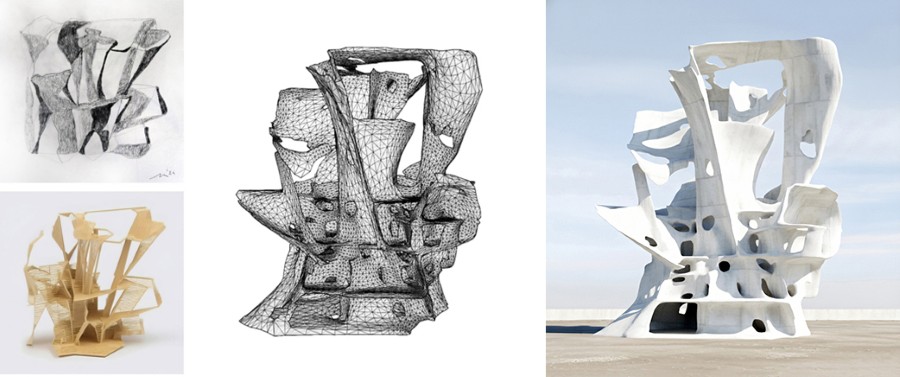Hybrid Artefacts
Transforming Abstract Drawings into Generated Architecture
This research investigates how abstract drawings can be systematically transformed into architectural forms via AI image generation. The study introduces "Hybrid Artefacts", a distinct subcategory of design objects born from the synthesis of human intuition and machine logic. These artefacts occupy a liminal domain between author and artificial intelligence.
The methodology centres on calibrating the threshold between generative chaos and predictable control. By systematically varying parameters such as classifier-free guidance (CFG) and sampling steps, the research identifies a narrow operational band where visually unpredictable forms emerge, forms that occasionally achieve spatial coherence. These 'key frames' are identified through a combination of aesthetic evaluation and iterative pattern recognition across multiple generational batches. Successful parameters are then visually coded into a node-based workflow that maintains controlled unpredictability while streamlining production.
Three case studies contextualize these findings: (1) constructing speculative narratives around self-referential Hybrid Artefacts and (2) replicating the process using abstract drawings by Hermann Finsterlin and Friedrich Kiesler. The third case study implements a double transformation process: abstract drawings are first converted into digital models, then materialized as 3D-printed physical objects.
The resulting body of work, Artificial ~ Nature, demonstrates how systematic curation of AI-generated forms produces an organic architectural language that appear naturally evolved rather than digitally constructed. These artefacts share underlying morphological patterns that create visual coherence across diversity. The findings demonstrate how creative agency can be shared between human and artificial intelligence, suggesting an alternative approach for design practice.
Keywords: Hybrid Artefacts, AI-generated architecture, human-machine collaboration, generative design, latent space navigation, computational creativity
Latent space: High-dimensional mathematical space where AI models encode and organize learned information, with similar concepts positioned closer together, allowing the model to navigate between different possible outputs by moving through this abstract territory.
Classifier-free guidance (CFG): A parameter that controls how much the model should follow the text prompt when generating an image.
Sampling Steps: The number of iterations used to denoise a random noise image into a final picture.
Ⓜ Marcel Moonen, PhD researcher, Design Based Doctorate, TU Berlin, 2023 - 2026, Hybrid Artefacts [EDUCATIONAL PURPOSE ONLY] M. Production